Excursion to the Moscow production of components for communication networks. Part one
Our long-time partner, Svyazstroydetal, invited us on a tour of its production. We walked through the shops, got acquainted with the equipment, reviewed the exposition and found out why the companies are not afraid of the Chinese and how it lives in reality, "Kanban" and "6 Sigma".

In the first part we will talk about products. More precisely, about how it all began and how modern components for communication networks should look like.
Not only users, but also industry professionals often do not realize how complex technologies and a large amount of labor are behind things that seem so simple and natural to us. First of all, we are talking about auxiliary infrastructure components, for example, the same concrete wells for cable ducts. After all, it would seem that it could be easier?
')
Therefore, we decided to introduce you to our partner and his key asset. In our blog, an excursion to the plant of the company " Svyazstroydetal " - a manufacturer of cables, plastic couplings, metal communication cabinets and many other components for communication networks.
Svyazstroydetal (SSD) and Rostelecom are not just a supplier and customer. At one time, when Rostelecom North-West was just beginning to develop GPON technology, it was necessary to go on virgin soil. There was no base, there was nothing to take as a basis, and foreign experience was not suitable for Russia, because in Asian countries other operating conditions, regulatory requirements and a completely different climate. SSD specialists, together with the Rostelecom North-West team, had to independently figure out how to adapt technologies to our networks, conduct joint research, test new product samples and eliminate flaws. Companies faced a lot of nontrivial problems (for example, finding the right plastic), but gradually gained the necessary experience and were able to achieve effective networking. This was the beginning of a great friendship: Rostelecom highly appreciated the fact that the SSD is ready to work for the future and take part in research work.
Alexey Nikitin, technical director of Rostelecom North-West, who also attended the excursion, noted the adaptability of the SJS, the desire to use the most advanced technologies, introduce modern materials and equipment, improve the efficiency of working processes. In addition, he praised the use of modern management techniques that can significantly optimize the operation of the enterprise and increase its effectiveness - the Japanese "Kanban", "6 Sigma" and several others.

Plastics casting shop. Photo: "Svyazstroydetal"
The companies unite not only working ties, but also interest in the field of education. Rostelecom has a specialized department at the University. Bonch-Bruyevich, cooperates with educational institutions in Arkhangelsk and Vologda. In particular, experimental laboratories are deployed there, where students can study the features of the construction and operation of modern optical communication networks or simulate various malfunctions and ways to eliminate them. Svyazstroydetal also has training programs in several universities and collaborates with World Skills Russia.
In 2017, cooperation will be actively developed. Among the priorities of Rostelecom for 2017 are the development of the Internet in cottage villages, the deployment of communication networks in new construction areas and the development of projects for connecting production and office facilities with the construction of point-to-point optical networks. All these areas imply a lot of work on the creation of new networks, so that there are good prospects for cooperation.
The history of the plant began in 1974. During Soviet times, he was a subsidiary manufacturing enterprise of the trust "Mostelefonstroy." The main activity was the production of reinforced concrete structures, although everything had to be done, including wooden fencing of work sites.
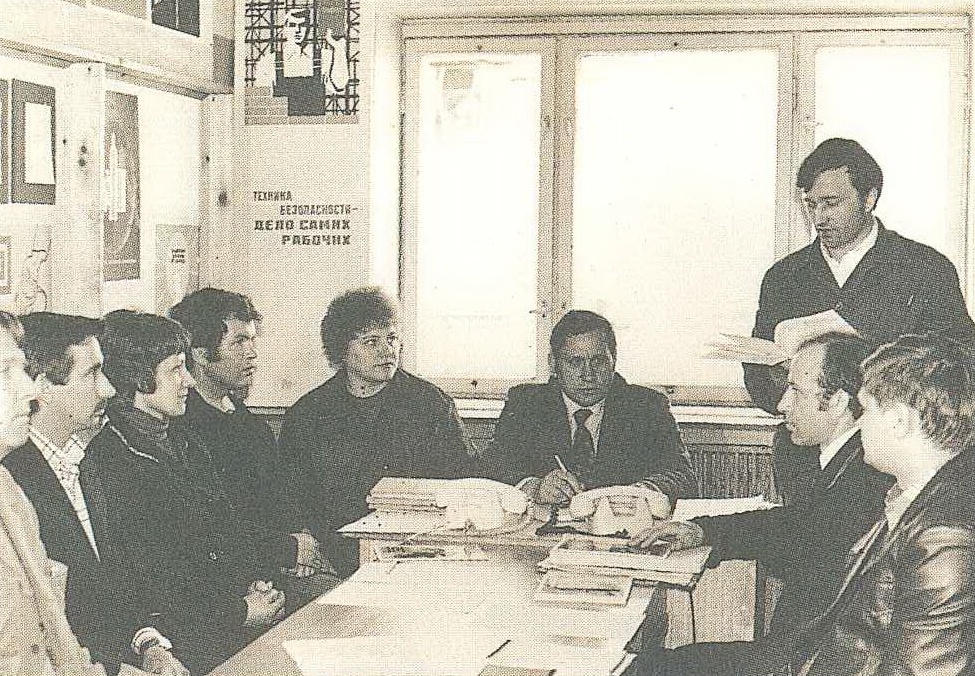
Establishment of a design office, 1978. Photo from the archive "Svyazstroydetal"
In the 90s, a cooperative was established on the basis of the plant, which began working with commercial customers. Due to this, the plant was able to survive the disappearance of the main customer in the face of the parent company and preserve the main areas of work even in the difficult conditions of the “turbulence of the 90s”. It is indicative of the fact that the current director general of the SJS, Nikolai Yushchenko, came to this plant as early as 1974 as a mechanic in a concrete shop and went all the way to the head. Commercial director Alexey Anisimov, who conducted the excursion, has been working at the enterprise for 17 years and 10 of them - in the current position.
The production site of the company is located, by modern standards, almost in the center of Moscow - in the industrial zone near the South Port, not far from the Kozhukhovskaya metro station. The plant occupies about three hectares, on which there are several workshops, an administrative building, a warehouse for finished products, and storage of components for the production of reinforced concrete products, including sand and cement. And open spaces are often used to store finished products.
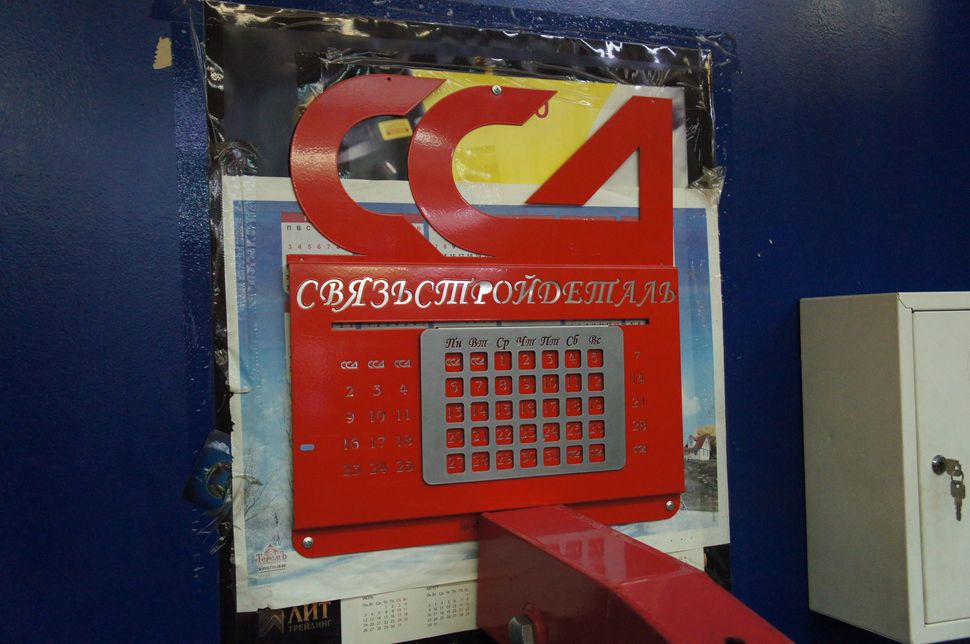
The metal calendar is stylish!
Initially, the company employed about 100 people. Nowadays, there are 600-700 employees in the SSD. The annual turnover is, according to management, “between two and three billion rubles.” 60% of the company's product range is own production, the remaining 40% is purchased on the side in order to ensure the comprehensiveness of supplies for projects. An expensive tool (for example, a Japanese welding machine worth $ 10,000) can fall into these 40%.
Rostelecom is one of the largest customers of SSD, but its share in turnover is only about 10%. Finished products and components to the plant supply about 100 enterprises, which are located in different countries and are often the leading market players. One of the key partners is 3M.
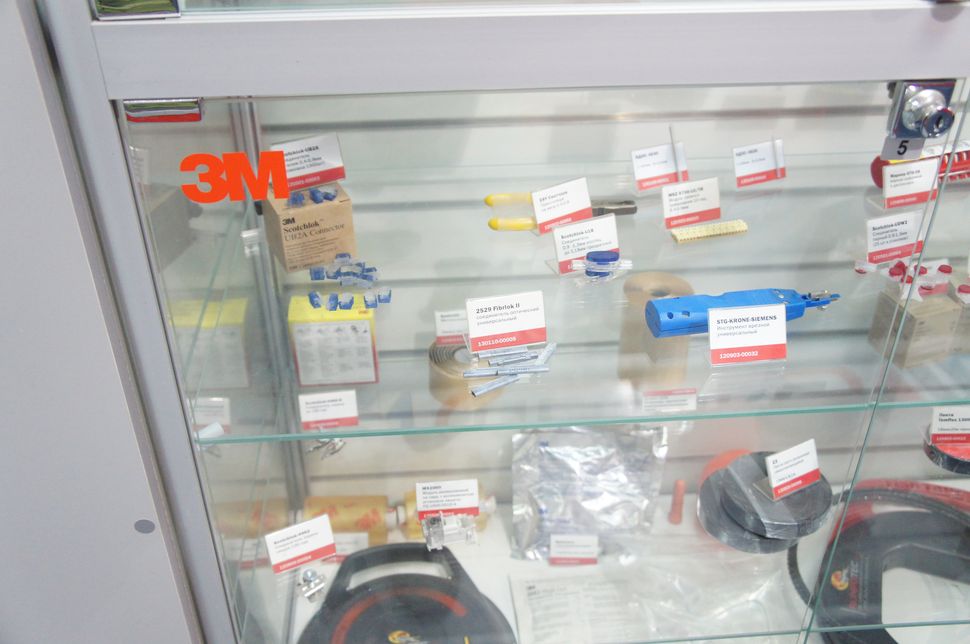
The SSD also has its own transport department, which includes about 30 cars, eight trucks, dump trucks and other equipment. The company's fleet is used to deliver products to customers and for centralized transfer of orders to warehouses outside Moscow Ring Road - in order not to create problems for customers with passes to the city. If desired, you can pick up an order from the territory of the enterprise. For the delivery of goods around the world SSD cooperates with transport companies, and it also brings products to their bases on their machines.
The SSD has three main activities: the production of plastic products (couplings, joints), metal (cabinets, racks) and reinforced concrete (for example, communication wells). There are about 6,000 items in the assortment of the enterprise.
Sales is engaged in the sales department. Daily it processes 200-300 applications. This is a very good indicator - about 30 applications per day are typical for an ordinary production company.
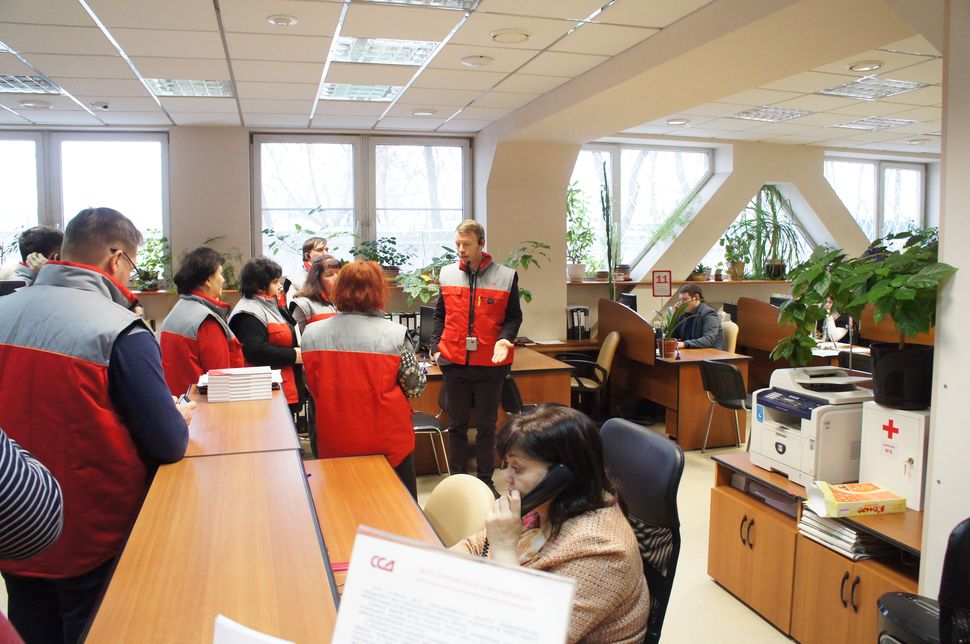
Sales office
Next to the sales department at the stand are product samples. This allows managers to immediately demonstrate the product to customers, and customers - it is easy to navigate in it.
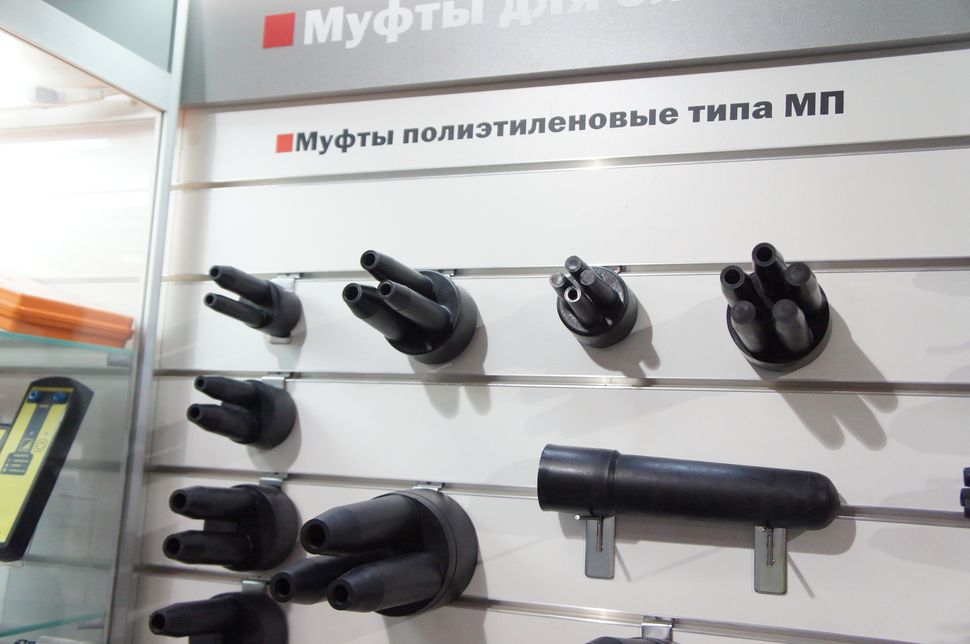
Polyethylene couplings, entrance parts
SSD makes everything that is necessary for laying of a cable, except for some elementary plastic parts and specific products like cast-iron hatches. The company buys these related components from third-party suppliers and always keeps it in stock - so that customers can buy everything they need in one place.
The factory has launched production of typical products, but the company accepts individual orders for the manufacture of modified goods that are suitable for the needs of specific customers.

Part of the range of couplings and distributors
The company released the first MTOK-96 clutch in 1996, at a time when products of this type were not yet and it was unclear exactly how it should look.
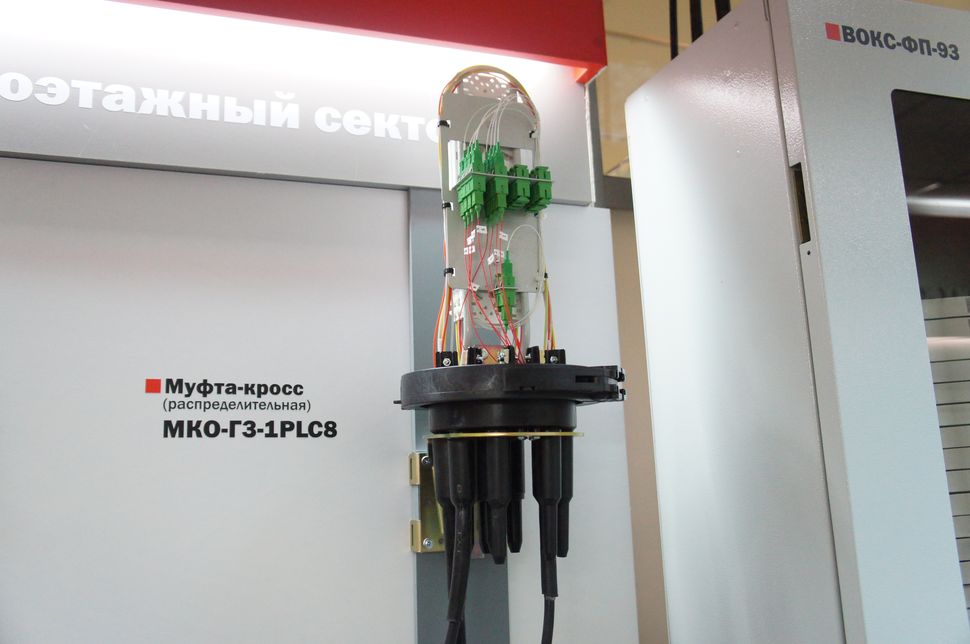
Open coupling. Fiber and connectors are clearly visible. In working condition, the clutch closes the top cover. Most couplings are sealed.
Since then, the product design has been constantly improved, but the main features of the very first coupling have remained to this day.
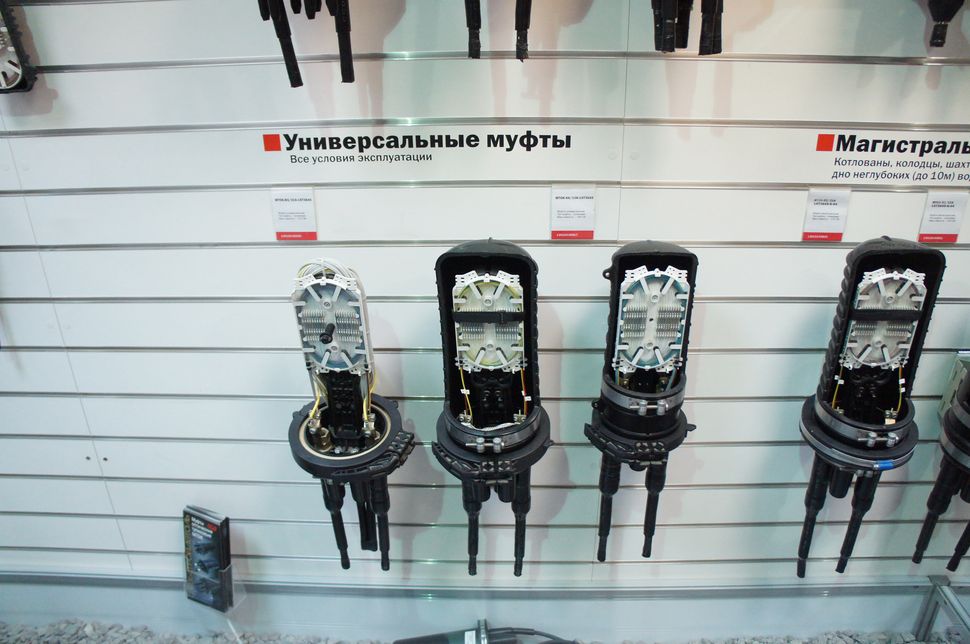
In the line there are quite a few models of couplings for different applications: indoor, outdoor, industrial, where special requirements are imposed on dust and moisture protection, trunk cables with placement in collectors or in the open air
Couplings manufactured by the company in the 90s were sharpened for traditional, copper connections. Now almost all communication channels are built on optics - copper has remained in the old lines or at facilities with increased requirements for reliability and security - military, in state security structures.

Despite the opportunity to save by eliminating obsolete products, Svyazstroydetal
continues to produce a range of components for copper connections. This allows the company to maintain the reputation of a reliable partner - if the copper cable is damaged or needs to be replaced, customers can still contact the SSD and will not face a lack of spare parts.
However, not only couplings produce SSDs, but a large number of other components necessary for building communication networks.
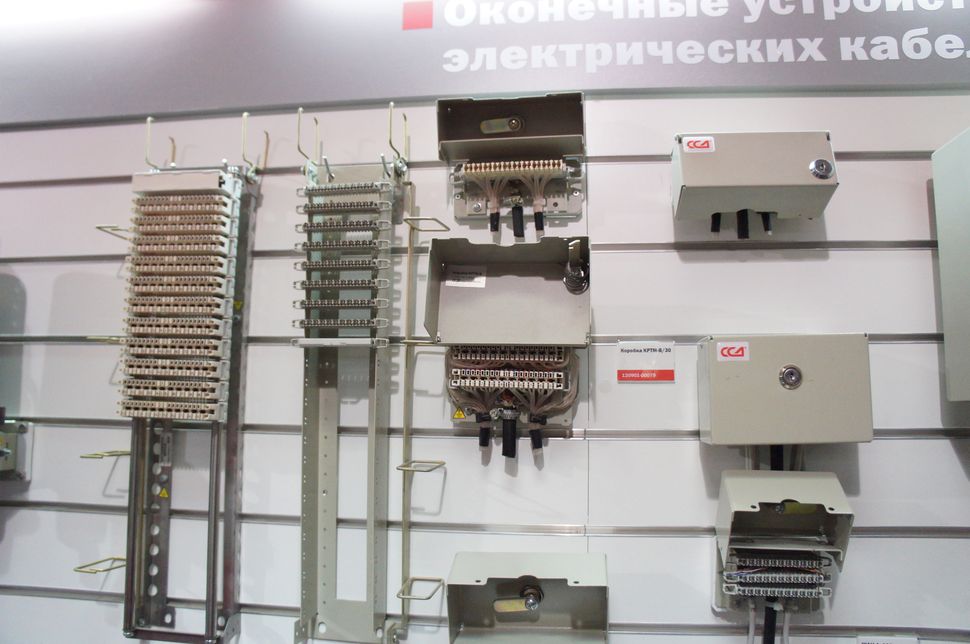
The company actively cooperates with Rostelecom in the framework of projects to provide Internet access to end-users through GPON networks. On the stands in the SSD office, you can see four distribution schemes for the communication channels of the end customers, which are implemented by the operator. For example, in the photo below - the first scheme, which was built by Rostelecom North-West.

The second example is the network deployed by Rostelecom in the Urals. Both Moscow networks are presented - old and new.
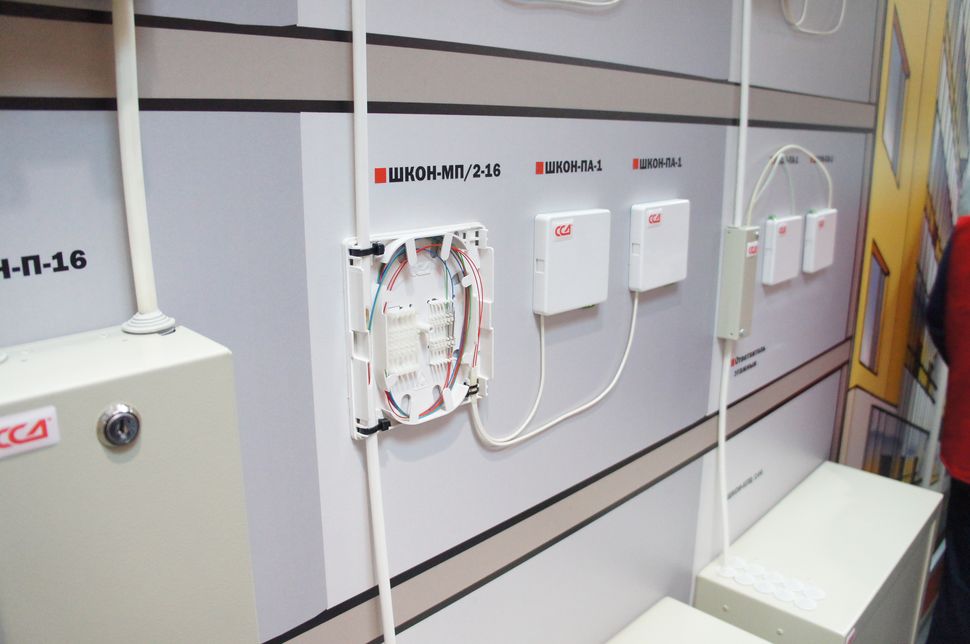
Network building is constantly being improved. For example, they have recently developed a new type of cable in which wires run loose inside rigid insulation. This makes it possible to cut off part of the cable from the side and pull out only the necessary wires that will already go to the client. With the usual cable, such a focus will not work, since the wires there are laid very closely and intertwined with each other.

This allows you not to make huge reserves of cable for each connection, and use one common cable for several clients.
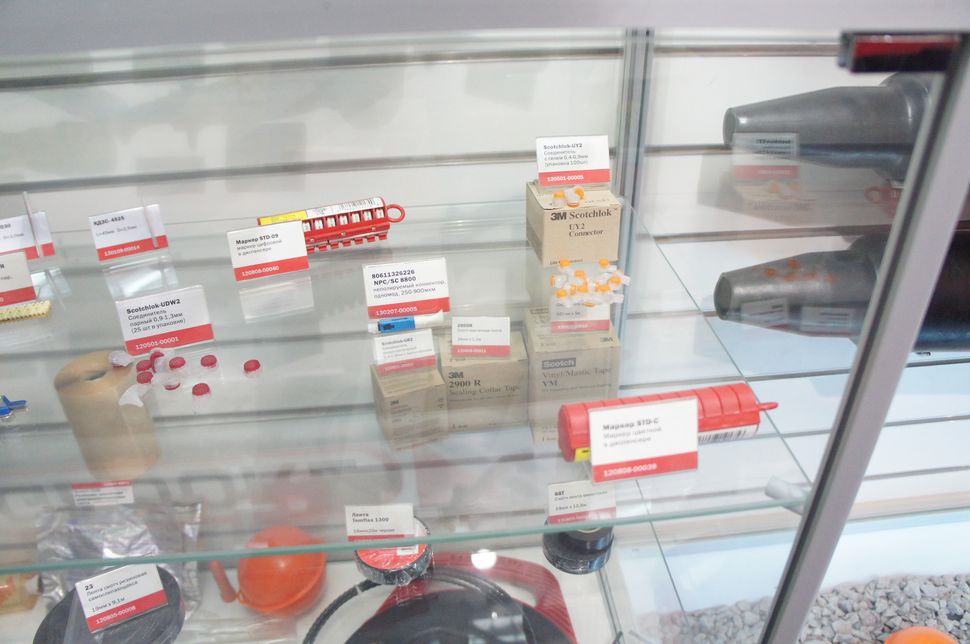
In the product range there are also many auxiliary trifles, including third-party production.
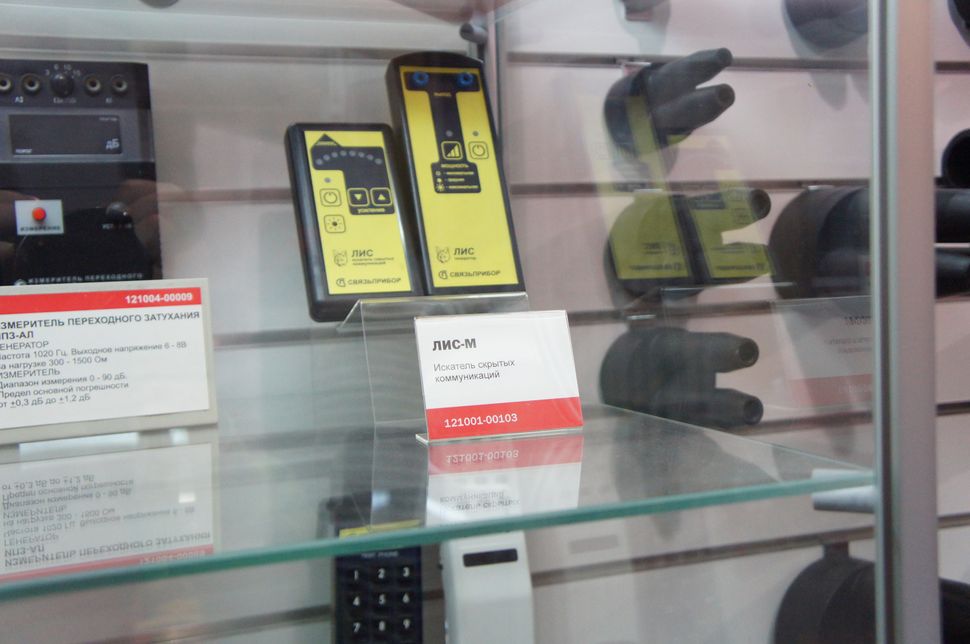
And tools.
In communication with any representatives of Russian industries, journalists are always trying to find out - and how do they manage to deal with the expansion of Chinese companies? Recently, one more question has been added to this question - how are things in the industry with import substitution?
If we talk about suppliers, then Svyazstroydetal has many reliable partners among Russian enterprises. For example, the metal supplies Novolipetsk plant. There are domestic suppliers of plastics and other components. On the other hand, several times during the excursion, Aleksei made a reservation that the company had to develop this or that direction independently, since the partners either failed or could not provide the necessary parameters, terms and quality.
But if the production of mass raw materials in Russia is well adjusted, with more specific products there are difficulties. For example, we have metal for production, and metal for molds (it should be of higher quality, durability and with other properties) is forced to buy the plant in Sweden: in Russia it is not made due to low demand. Some high-quality plastics have to be ordered from foreign manufacturers. China supplies many simple, standard products (wires, combs): there they have so optimized technology and production and achieved such high sales volumes that it makes no sense to compete with them.

Despite the flow of Chinese goods, there is and has always been a steady demand for the products of the Svyazstroydetal company - the company often works in two, and separate areas and in three shifts. The company feels confident in the market, and its products were competitive even before the ruble devaluation. After the devaluation, it became easier: numerous intermediary companies with no own resources, who were selling Chinese equipment, dropped out of the tender for deliveries.
The high quality of products (including compliance with strict Russian requirements for temperature conditions - up to -60 ° C), the location of production in Russia (easier logistics, shorter delivery times, no delays and difficulties with customs), and flexibility with the customer (the ability to take into account his wishes, modify products to specific requirements and specifications).
The production of high-quality products requires high-tech equipment. But the backwardness of the machine tool industry is the scourge of modern Russia: some automata have completely disappeared, while others are machine tools from the times of the USSR with minimal rework — for example, with attached sensors and electronic control systems.
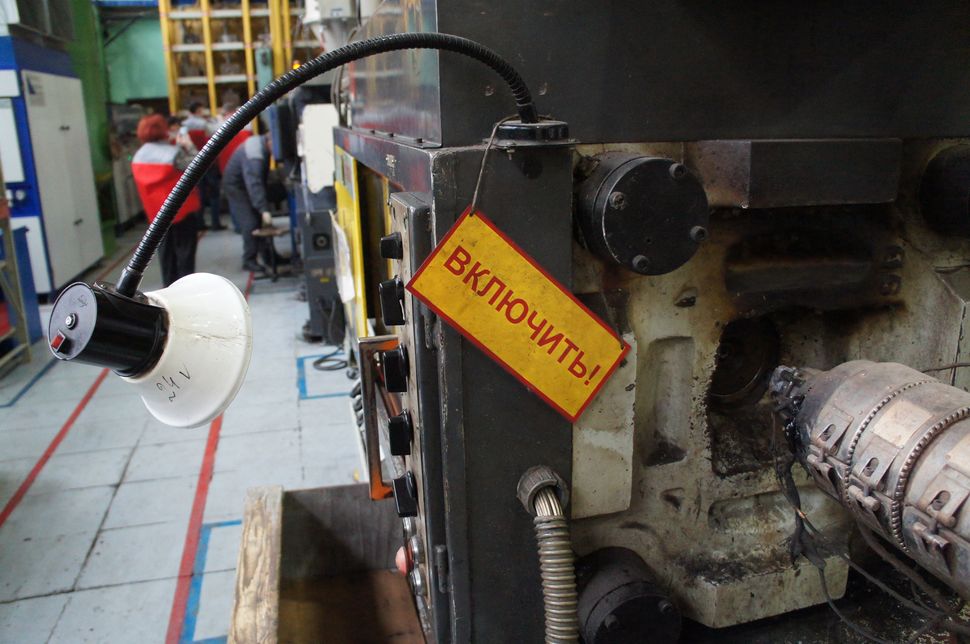
Another Russian problem is the irresponsibility of suppliers. SSD more than once faced with a deadline on the part of partners. Therefore, many areas where previously it was possible to get by with finished products, now the company has to close independently. For example, a ring of aviation silicone, which seals the clutch when locking, was first bought on the side, but the supplier once seriously failed the delivery: a large batch of clutches eventually hung in the warehouse for a long time, the order was thwarted, and the customer was dissatisfied. Therefore, the decision on independent production is not so much a way to increase profitability, as it is an opportunity to ensure production control and reliability of supplies.
In Russia, equipment has its own special requirements, which in many cases reliably protect a local manufacturer from competitors. The simplest example is temperature. In Europe, products such as couplings traditionally must withstand operation at temperatures down to -40 ° C. In Russia, this is not enough, such a temperature in many regions is not even considered to be particularly extreme - well, so chilly, but that's okay. Products used in our country must withstand up to -60 ° C, and in open areas, with frost and in the wind, their temperature can actually reach this mark. And in the summer, the black clutch in the southern regions may well warm up to + 70C.
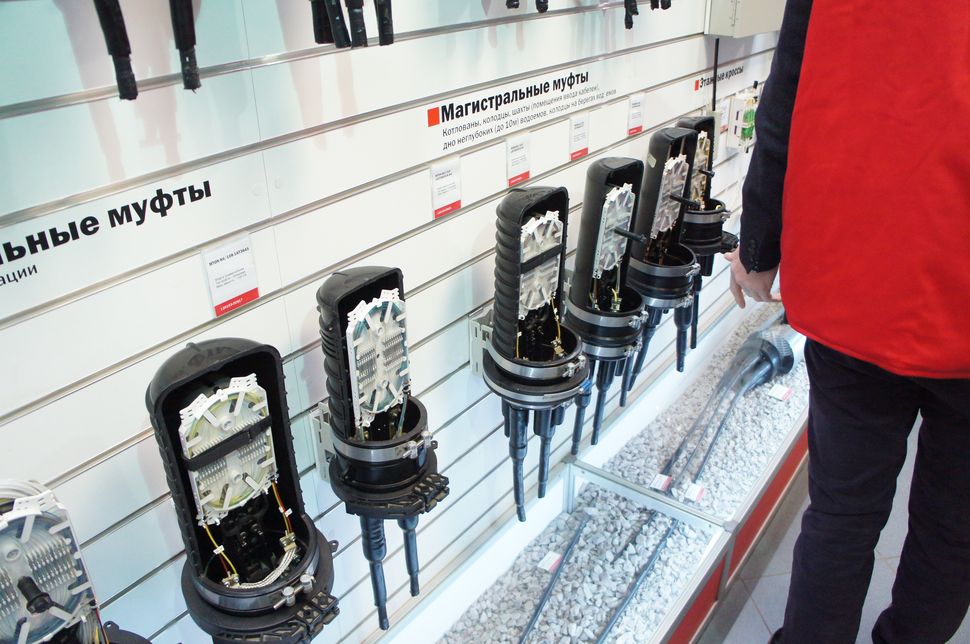
All couplings must withstand extreme conditions
This imposes very stringent requirements on both plastic and construction. To satisfy them, the SSD had to look for new types of plastics, refine them for their tasks, conduct research and development, laboratory and real testing.
The second requirement is strength. According to Russian regulations, the coupling must withstand 20% of the effort to break the cable. Such a reserve is necessary in different situations - somewhere they can hook and pull the cable, somewhere the wires are frosted over and sag in the winter, creating tremendous efforts at breaking. In the west there are no such requirements - including because there they use thinner cables that are laid into the cable sewage system, and we often put the cable directly into the ground.
In fact, 20% is a lot. After all, the cable is twisted multi-core connections (often - also in armor), which have tremendous strength. Making the clutch endure such an effort is very difficult. For this you need metal lead parts and a special design.
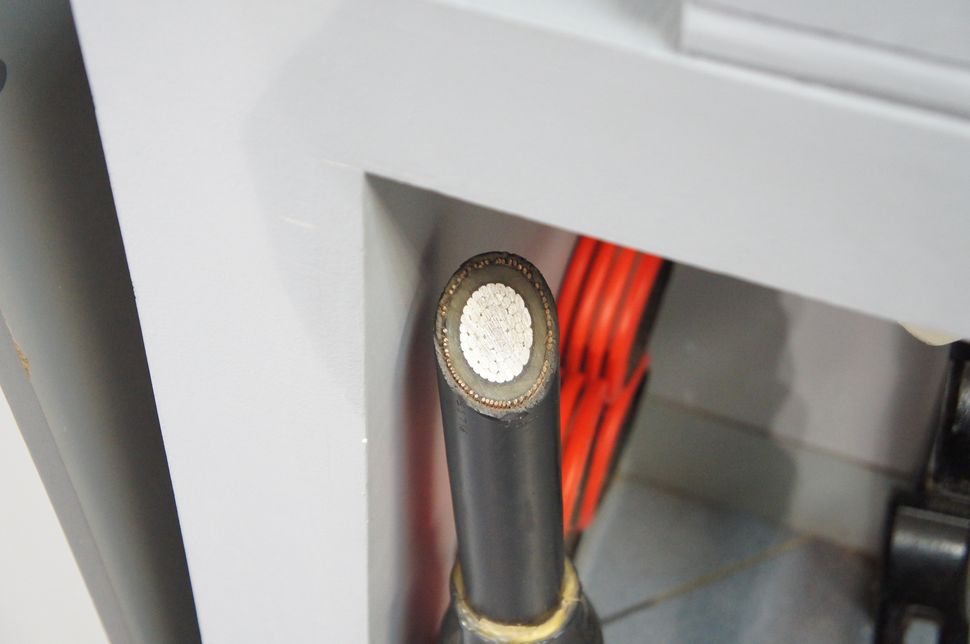
Cable in cut. Can you imagine how durable it is?
Interestingly, when testing the reliability during freezing (the test scenario assumes a breakthrough of a pipe with boiling water in the collector, after which the water freezes), if the coupling is standing upright, the frozen water will crush it anyway. But if you put the clutch horizontally, it will remain intact and airtight. Therefore, the manufacturer recommends installing the couplings in the manifolds horizontally. Russian couplings, in contrast to Western ones, by the way, can be installed without special fasteners.
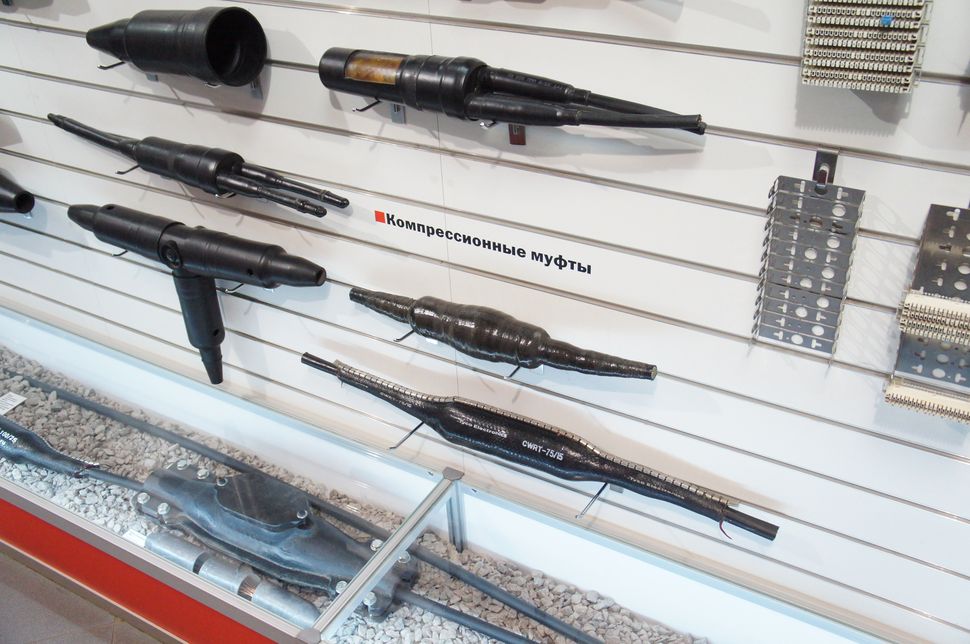
A separate requirement is durability. The estimated lifetime of the coupling is 25 years. During the whole period the product must retain its working properties. And this applies to all components - plastic and metal parts, gaskets, sealants. Interestingly, black, despite the greater heating in summer, is the most light-resistant - that is why all the couplings are black.
Most couplings, especially designed for work in the open air, in industrial premises with high levels of dirt and dust, as well as in other places with a large accumulation of moisture and dust, are to be sealed.

Example of sealed couplings
This is achieved in different ways. In some cases, a compound is used, including a two-component compound, which is poured during installation. In this case, the installation itself can be done in difficult conditions, so you need to be able to ensure the most simple preparation and pouring of the composition. In other situations, a soft-padded construction with a locking ring is used, which squeezes the parts of the coupling and the gasket, ensuring the tightness of the coupling.
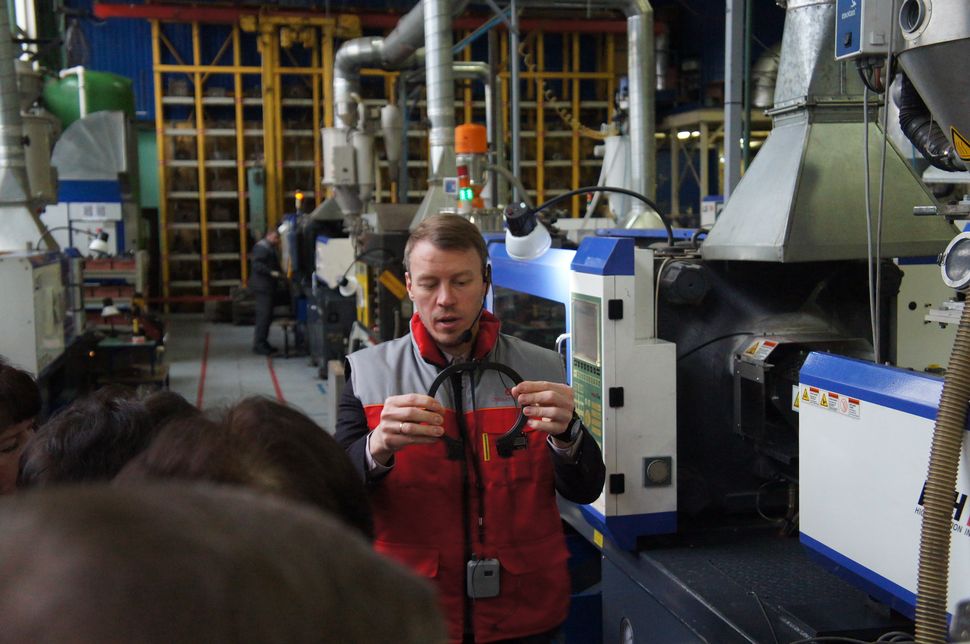
Alexey Anisimov demonstrates the locking ring coupling
Some couplings use aviation silicone pads, which, when compressed, turn into almost flat tapes. During the entire service life, they should retain their properties: straightening when opening the coupling, and then compress again when closing, reliably sealing the connection.

The gasket should remain soft and after 25 years, which it will hold under pressure in the coupling housing
Finally, in some situations, a semi-soft gel is applied, which sticks to the closed lid, sealing the box or sleeve when closing.

Clutch with a sealing cover semi-soft gel. Not only the cap is sealed, but also the cable glands.
The solution is convenient, but imagine how much effort it took to create such a gel and to ensure that it retains its properties for a lifetime, that is, at least 25 years.

On the left - the coupling, the opening lid of which is sealed with a special gel, on the right - the traditional one, under the clamping ring.
SSD has its own laboratory, which uses accelerated aging techniques in order to find out whether the company’s products will be able to withstand work for 25 years in harsh conditions. The company's specialists check the effects of temperature (and drops), humidity (and its drops), the impact of liquids, including corrosive dust, the effect of working in industrial conditions with dust and vibrations, aggressive liquids and gases, and simulate other critical situations.
We saw from which components modern communication lines are assembled. It's time to stroll to the holy of holies of the plant - where these parts produce. This will be our next material.

In the first part we will talk about products. More precisely, about how it all began and how modern components for communication networks should look like.
Not only users, but also industry professionals often do not realize how complex technologies and a large amount of labor are behind things that seem so simple and natural to us. First of all, we are talking about auxiliary infrastructure components, for example, the same concrete wells for cable ducts. After all, it would seem that it could be easier?
')
Therefore, we decided to introduce you to our partner and his key asset. In our blog, an excursion to the plant of the company " Svyazstroydetal " - a manufacturer of cables, plastic couplings, metal communication cabinets and many other components for communication networks.
Not just a supplier
Svyazstroydetal (SSD) and Rostelecom are not just a supplier and customer. At one time, when Rostelecom North-West was just beginning to develop GPON technology, it was necessary to go on virgin soil. There was no base, there was nothing to take as a basis, and foreign experience was not suitable for Russia, because in Asian countries other operating conditions, regulatory requirements and a completely different climate. SSD specialists, together with the Rostelecom North-West team, had to independently figure out how to adapt technologies to our networks, conduct joint research, test new product samples and eliminate flaws. Companies faced a lot of nontrivial problems (for example, finding the right plastic), but gradually gained the necessary experience and were able to achieve effective networking. This was the beginning of a great friendship: Rostelecom highly appreciated the fact that the SSD is ready to work for the future and take part in research work.
Alexey Nikitin, technical director of Rostelecom North-West, who also attended the excursion, noted the adaptability of the SJS, the desire to use the most advanced technologies, introduce modern materials and equipment, improve the efficiency of working processes. In addition, he praised the use of modern management techniques that can significantly optimize the operation of the enterprise and increase its effectiveness - the Japanese "Kanban", "6 Sigma" and several others.

Plastics casting shop. Photo: "Svyazstroydetal"
The companies unite not only working ties, but also interest in the field of education. Rostelecom has a specialized department at the University. Bonch-Bruyevich, cooperates with educational institutions in Arkhangelsk and Vologda. In particular, experimental laboratories are deployed there, where students can study the features of the construction and operation of modern optical communication networks or simulate various malfunctions and ways to eliminate them. Svyazstroydetal also has training programs in several universities and collaborates with World Skills Russia.
In 2017, cooperation will be actively developed. Among the priorities of Rostelecom for 2017 are the development of the Internet in cottage villages, the deployment of communication networks in new construction areas and the development of projects for connecting production and office facilities with the construction of point-to-point optical networks. All these areas imply a lot of work on the creation of new networks, so that there are good prospects for cooperation.
From subsidiary to large-scale production
The history of the plant began in 1974. During Soviet times, he was a subsidiary manufacturing enterprise of the trust "Mostelefonstroy." The main activity was the production of reinforced concrete structures, although everything had to be done, including wooden fencing of work sites.

Establishment of a design office, 1978. Photo from the archive "Svyazstroydetal"
In the 90s, a cooperative was established on the basis of the plant, which began working with commercial customers. Due to this, the plant was able to survive the disappearance of the main customer in the face of the parent company and preserve the main areas of work even in the difficult conditions of the “turbulence of the 90s”. It is indicative of the fact that the current director general of the SJS, Nikolai Yushchenko, came to this plant as early as 1974 as a mechanic in a concrete shop and went all the way to the head. Commercial director Alexey Anisimov, who conducted the excursion, has been working at the enterprise for 17 years and 10 of them - in the current position.
The production site of the company is located, by modern standards, almost in the center of Moscow - in the industrial zone near the South Port, not far from the Kozhukhovskaya metro station. The plant occupies about three hectares, on which there are several workshops, an administrative building, a warehouse for finished products, and storage of components for the production of reinforced concrete products, including sand and cement. And open spaces are often used to store finished products.

The metal calendar is stylish!
Initially, the company employed about 100 people. Nowadays, there are 600-700 employees in the SSD. The annual turnover is, according to management, “between two and three billion rubles.” 60% of the company's product range is own production, the remaining 40% is purchased on the side in order to ensure the comprehensiveness of supplies for projects. An expensive tool (for example, a Japanese welding machine worth $ 10,000) can fall into these 40%.
Rostelecom is one of the largest customers of SSD, but its share in turnover is only about 10%. Finished products and components to the plant supply about 100 enterprises, which are located in different countries and are often the leading market players. One of the key partners is 3M.

The SSD also has its own transport department, which includes about 30 cars, eight trucks, dump trucks and other equipment. The company's fleet is used to deliver products to customers and for centralized transfer of orders to warehouses outside Moscow Ring Road - in order not to create problems for customers with passes to the city. If desired, you can pick up an order from the territory of the enterprise. For the delivery of goods around the world SSD cooperates with transport companies, and it also brings products to their bases on their machines.
How to build a relationship
The SSD has three main activities: the production of plastic products (couplings, joints), metal (cabinets, racks) and reinforced concrete (for example, communication wells). There are about 6,000 items in the assortment of the enterprise.
Sales is engaged in the sales department. Daily it processes 200-300 applications. This is a very good indicator - about 30 applications per day are typical for an ordinary production company.

Sales office
Next to the sales department at the stand are product samples. This allows managers to immediately demonstrate the product to customers, and customers - it is easy to navigate in it.

Polyethylene couplings, entrance parts
SSD makes everything that is necessary for laying of a cable, except for some elementary plastic parts and specific products like cast-iron hatches. The company buys these related components from third-party suppliers and always keeps it in stock - so that customers can buy everything they need in one place.
The factory has launched production of typical products, but the company accepts individual orders for the manufacture of modified goods that are suitable for the needs of specific customers.

Part of the range of couplings and distributors
The company released the first MTOK-96 clutch in 1996, at a time when products of this type were not yet and it was unclear exactly how it should look.

Open coupling. Fiber and connectors are clearly visible. In working condition, the clutch closes the top cover. Most couplings are sealed.
Since then, the product design has been constantly improved, but the main features of the very first coupling have remained to this day.

In the line there are quite a few models of couplings for different applications: indoor, outdoor, industrial, where special requirements are imposed on dust and moisture protection, trunk cables with placement in collectors or in the open air
Couplings manufactured by the company in the 90s were sharpened for traditional, copper connections. Now almost all communication channels are built on optics - copper has remained in the old lines or at facilities with increased requirements for reliability and security - military, in state security structures.

Despite the opportunity to save by eliminating obsolete products, Svyazstroydetal
continues to produce a range of components for copper connections. This allows the company to maintain the reputation of a reliable partner - if the copper cable is damaged or needs to be replaced, customers can still contact the SSD and will not face a lack of spare parts.
However, not only couplings produce SSDs, but a large number of other components necessary for building communication networks.

The company actively cooperates with Rostelecom in the framework of projects to provide Internet access to end-users through GPON networks. On the stands in the SSD office, you can see four distribution schemes for the communication channels of the end customers, which are implemented by the operator. For example, in the photo below - the first scheme, which was built by Rostelecom North-West.

The second example is the network deployed by Rostelecom in the Urals. Both Moscow networks are presented - old and new.

Network building is constantly being improved. For example, they have recently developed a new type of cable in which wires run loose inside rigid insulation. This makes it possible to cut off part of the cable from the side and pull out only the necessary wires that will already go to the client. With the usual cable, such a focus will not work, since the wires there are laid very closely and intertwined with each other.

This allows you not to make huge reserves of cable for each connection, and use one common cable for several clients.

In the product range there are also many auxiliary trifles, including third-party production.

And tools.
A little about import substitution and the fight against Chinese manufacturers
In communication with any representatives of Russian industries, journalists are always trying to find out - and how do they manage to deal with the expansion of Chinese companies? Recently, one more question has been added to this question - how are things in the industry with import substitution?
If we talk about suppliers, then Svyazstroydetal has many reliable partners among Russian enterprises. For example, the metal supplies Novolipetsk plant. There are domestic suppliers of plastics and other components. On the other hand, several times during the excursion, Aleksei made a reservation that the company had to develop this or that direction independently, since the partners either failed or could not provide the necessary parameters, terms and quality.
But if the production of mass raw materials in Russia is well adjusted, with more specific products there are difficulties. For example, we have metal for production, and metal for molds (it should be of higher quality, durability and with other properties) is forced to buy the plant in Sweden: in Russia it is not made due to low demand. Some high-quality plastics have to be ordered from foreign manufacturers. China supplies many simple, standard products (wires, combs): there they have so optimized technology and production and achieved such high sales volumes that it makes no sense to compete with them.

Despite the flow of Chinese goods, there is and has always been a steady demand for the products of the Svyazstroydetal company - the company often works in two, and separate areas and in three shifts. The company feels confident in the market, and its products were competitive even before the ruble devaluation. After the devaluation, it became easier: numerous intermediary companies with no own resources, who were selling Chinese equipment, dropped out of the tender for deliveries.
The high quality of products (including compliance with strict Russian requirements for temperature conditions - up to -60 ° C), the location of production in Russia (easier logistics, shorter delivery times, no delays and difficulties with customs), and flexibility with the customer (the ability to take into account his wishes, modify products to specific requirements and specifications).
The production of high-quality products requires high-tech equipment. But the backwardness of the machine tool industry is the scourge of modern Russia: some automata have completely disappeared, while others are machine tools from the times of the USSR with minimal rework — for example, with attached sensors and electronic control systems.

Another Russian problem is the irresponsibility of suppliers. SSD more than once faced with a deadline on the part of partners. Therefore, many areas where previously it was possible to get by with finished products, now the company has to close independently. For example, a ring of aviation silicone, which seals the clutch when locking, was first bought on the side, but the supplier once seriously failed the delivery: a large batch of clutches eventually hung in the warehouse for a long time, the order was thwarted, and the customer was dissatisfied. Therefore, the decision on independent production is not so much a way to increase profitability, as it is an opportunity to ensure production control and reliability of supplies.
Special requirements
In Russia, equipment has its own special requirements, which in many cases reliably protect a local manufacturer from competitors. The simplest example is temperature. In Europe, products such as couplings traditionally must withstand operation at temperatures down to -40 ° C. In Russia, this is not enough, such a temperature in many regions is not even considered to be particularly extreme - well, so chilly, but that's okay. Products used in our country must withstand up to -60 ° C, and in open areas, with frost and in the wind, their temperature can actually reach this mark. And in the summer, the black clutch in the southern regions may well warm up to + 70C.

All couplings must withstand extreme conditions
This imposes very stringent requirements on both plastic and construction. To satisfy them, the SSD had to look for new types of plastics, refine them for their tasks, conduct research and development, laboratory and real testing.
The second requirement is strength. According to Russian regulations, the coupling must withstand 20% of the effort to break the cable. Such a reserve is necessary in different situations - somewhere they can hook and pull the cable, somewhere the wires are frosted over and sag in the winter, creating tremendous efforts at breaking. In the west there are no such requirements - including because there they use thinner cables that are laid into the cable sewage system, and we often put the cable directly into the ground.
In fact, 20% is a lot. After all, the cable is twisted multi-core connections (often - also in armor), which have tremendous strength. Making the clutch endure such an effort is very difficult. For this you need metal lead parts and a special design.

Cable in cut. Can you imagine how durable it is?
Interestingly, when testing the reliability during freezing (the test scenario assumes a breakthrough of a pipe with boiling water in the collector, after which the water freezes), if the coupling is standing upright, the frozen water will crush it anyway. But if you put the clutch horizontally, it will remain intact and airtight. Therefore, the manufacturer recommends installing the couplings in the manifolds horizontally. Russian couplings, in contrast to Western ones, by the way, can be installed without special fasteners.

A separate requirement is durability. The estimated lifetime of the coupling is 25 years. During the whole period the product must retain its working properties. And this applies to all components - plastic and metal parts, gaskets, sealants. Interestingly, black, despite the greater heating in summer, is the most light-resistant - that is why all the couplings are black.
Most couplings, especially designed for work in the open air, in industrial premises with high levels of dirt and dust, as well as in other places with a large accumulation of moisture and dust, are to be sealed.

Example of sealed couplings
This is achieved in different ways. In some cases, a compound is used, including a two-component compound, which is poured during installation. In this case, the installation itself can be done in difficult conditions, so you need to be able to ensure the most simple preparation and pouring of the composition. In other situations, a soft-padded construction with a locking ring is used, which squeezes the parts of the coupling and the gasket, ensuring the tightness of the coupling.

Alexey Anisimov demonstrates the locking ring coupling
Some couplings use aviation silicone pads, which, when compressed, turn into almost flat tapes. During the entire service life, they should retain their properties: straightening when opening the coupling, and then compress again when closing, reliably sealing the connection.

The gasket should remain soft and after 25 years, which it will hold under pressure in the coupling housing
Finally, in some situations, a semi-soft gel is applied, which sticks to the closed lid, sealing the box or sleeve when closing.

Clutch with a sealing cover semi-soft gel. Not only the cap is sealed, but also the cable glands.
The solution is convenient, but imagine how much effort it took to create such a gel and to ensure that it retains its properties for a lifetime, that is, at least 25 years.

On the left - the coupling, the opening lid of which is sealed with a special gel, on the right - the traditional one, under the clamping ring.
SSD has its own laboratory, which uses accelerated aging techniques in order to find out whether the company’s products will be able to withstand work for 25 years in harsh conditions. The company's specialists check the effects of temperature (and drops), humidity (and its drops), the impact of liquids, including corrosive dust, the effect of working in industrial conditions with dust and vibrations, aggressive liquids and gases, and simulate other critical situations.
We saw from which components modern communication lines are assembled. It's time to stroll to the holy of holies of the plant - where these parts produce. This will be our next material.
Source: https://habr.com/ru/post/323786/
All Articles